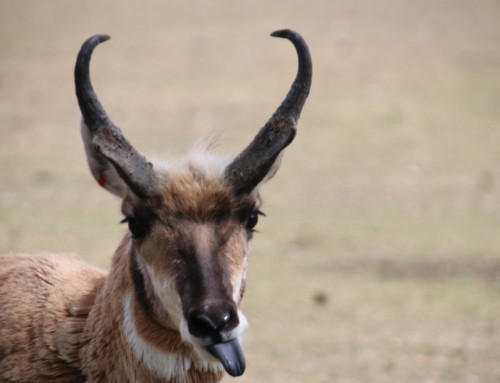Answer (to the question posed in ZooNews, our email newsletter):
The Canada Lynx (like most cats) will stay hidden waiting for an opportune time to ambush their prey. One of our girls was very interested in Gary, our barn cat, who was walking a little too closely around the lynx enclosure. It didn’t take long for the lynx to leap out and attempt to pounce (see picture below)! Luckily for Gary, the fence surrounding the lynx kept him safe! The three (3) foot fence surrounding the majority of our pens is both for your safety and the animals. If you’ve ever had a chance to witness the lynx stalking in its pen here at the zoo, you’d know that they can get their entire leg through the fence. Still, it’s quite amazing to watch our lynx engaged and using some natural instincts here at the zoo.

More about the Lynx:
Now that the Saskatoon Forestry Farm Park and Zoo has three different types of wild cats it is interesting to know which ones can purr. Purring is a vocalization that can occur while the animal is breathing in or out. Some domestic cats can even purr while eating.
Among the wild cats here, the Puma (Puma concolor) and the Canada Lynx (Lynx canadensis) are cats that are known to purr. The African lions do not purr in the same way as the smaller cats. Large cats like the lions, tigers, jaguars and leopard can make s similar noise only as they exhale instead of a constant noise.
The Canada Lynx is a member of the Felidae (cat family) and is found almost all across Canada. They are also found in Alaska, the Northern U. S. Rockies and at higher elevations in Wyoming, Colorado and Utah. Their main habitat is old growth boreal forest — birch, aspen, and conifers. Lynx, like most other wild cats, are mainly solitary and live within a home range, preferring areas undisturbed by humans. Their thick, long, soft, grayish-buff fur protects them from harsh winter weather. Even the bottoms of their large feet are covered with fur. As they walk, spreading their furry toes acts like snowshoes and enables them to walk more easily in deep snow. An older well-fed male may weigh up to 18 kg. Head and body length range from 81 – 91 cm with a stubby tail of 10.2 cm. Females are slightly smaller than males. Lynx are closely related to the bobcat but have much longer black ear tufts, longer sideburns and a black-tipped tail.
Although Lynx will eat mice, squirrels, and birds, their populations are closely tied to the snowshoe hare, their main prey. About every ten years or so snowshoe hare populations crash after a peak and the Lynx populations follow and decline in numbers. They are not strong runners and depend on stalking and ambush to catch prey. Lynx may move en masse, even entering cities to search for other food. Their one to four young, born 60 to 65 days after mating, may not survive in a season of famine. The populations begin to rebuild when the snowshoe hare populations rebound. Lynx probably live less than ten years in the wild. The kittens are born looking and sounding much like a litter of domestic cats, only larger and louder. In the wild, the mother feeds, protects and teaches the young with no help from the male. In captivity, males have been seen to play with and groom their young.
Although there have been reports of wolves preying on the lynx, trapping has been for a very long time the only important cause of death beside the cyclical decline due to the snowshoe hare population variations. Lynx are found on more continents than any other kind of wild cat: North America, Europe and Asia. The European and Asian Lynx are generally larger than the Canadian Lynx.
Perhaps on a visit to the Zoo, if you sit quietly long enough you may get a chance to hear the Lynx or even the Puma purr when they are relaxed.

